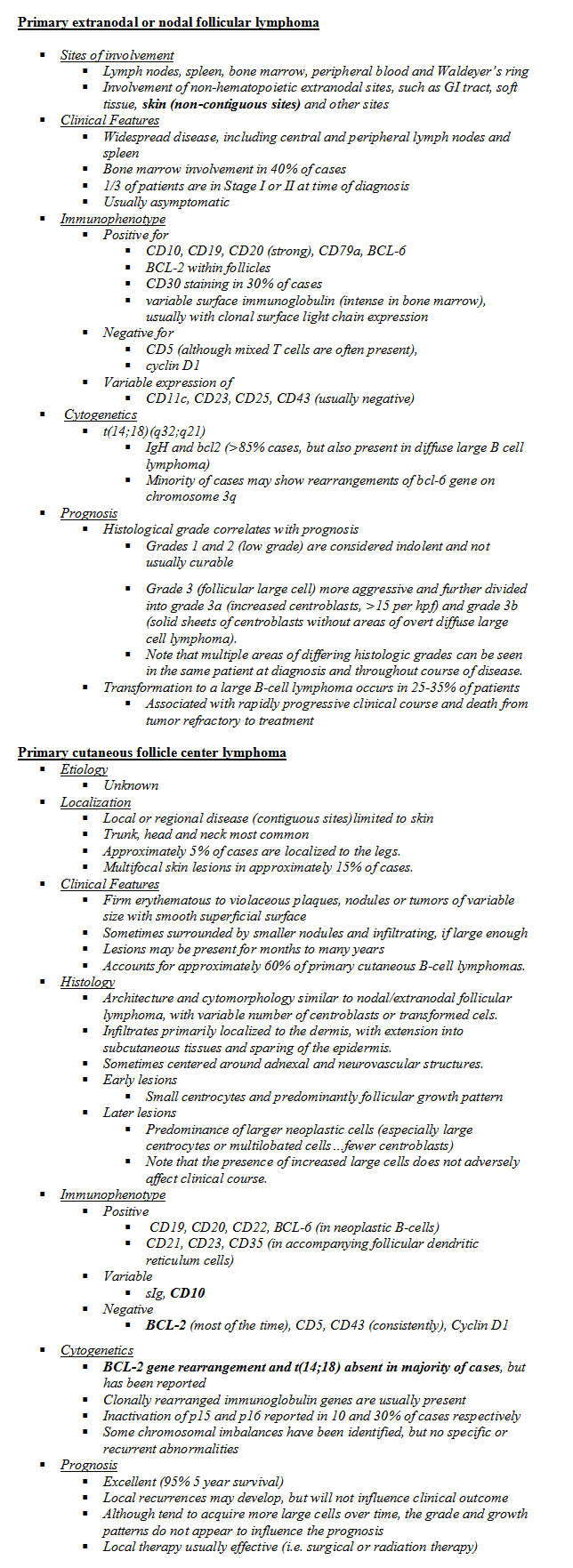
FINAL DIAGNOSIS Primary cutaneous follicle center lymphoma.
DISCUSSION
The histologic findings in this case demonstrate a nodular proliferation of small centrocyte-like lymphocytes admixed with a variable number of large transformed cells infiltrating soft tissue and forming true follicles with accompanying proliferation of follicular dendritic cells in a nodular pattern.
The differential diagnosis would include predominantly primary cutaneous follicle center lymphoma and follicular lymphoma, primary nodal type. Additional, less likely diagnostic considerations might also include extranodal marginal zone lymphoma (especially one with neoplastic colonization of reactive germinal centers) and an unusual presentation of mantle cell lymphoma, with soft tissue involvement. Based on H&E and immunohistochemical findings alone, one might also consider benign reactive follicular hyperplasia.
The presence of a clonal B-cell process (demonstrated by flow cytometry and cytogenetics analysis) essentially excludes a reactive process. The lack of a translocation involving the cyclin-D1 locus at chromosome 11q13 and lack of cyclin-D1 staining by immunohistochemical studies essentially excludes a diagnosis of mantle cell lymphoma.
Marginal zone lymphoma is largely excluded based on the histologic appearance (centrocyte appearing cells with no significant "monocytoid" B-cell component) and lack of evidence of plasmacytic differentiation.
Although one might consider a diagnosis of large cell lymphoma, the lack of significant areas of neoplastic centroblasts excludes that diagnosis.
Finally, the lack of bcl-2 staining within follicles and lack of a genetic rearrangement involving either the BCL2 or BCL6 gene loci makes secondary cutaneous involvement by a primary follicular lymphoma of nodal or extranodal origin an unlikely possibility.
The most appropriate and specific diagnosis for the findings described is primary cutaneous follicle center lymphoma. Synopses of the 2008 WHO descriptions of primary follicular lymphoma and primary cutaneous follicle center lymphoma follow. Note that one primary difference between these two diagnoses is that primary cutaneous follicle center lymphoma follows an indolent clinical course with the progressive accumulation of large transformed cells. However, unlike primary nodal or extranodal follicular lymphoma, primary cutaneous follicle center lymphoma is not affected prognostically by the accumulation of large cells and therefore need not be graded histologically.

In our case, the patient had two subsequent PET/CT scans, one immediately following surgical removal of the cutaneous lymphoma and one five months later, both of which showed no FDG-avid lymph nodes or masses from skull to thigh.
The other interesting finding in this case is the deletion present on the long arm of one chromosome 10. The deletion has been reported in B-cell lymphomas, including follicular lymphomas, but usually also in association with the presence of t(14;18). However, the significance of this deletion as an isolated finding is not clear.
Take home points about primary cutaneous follicular center cell lymphoma:
REFERENCES